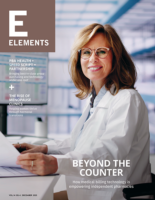Approximately 8 million healthcare workers are exposed to hazardous drugs in the U.S. each year. This puts not only them, but you and your pharmacy staff, at risk for both acute and chronic health issues. As you know, exposure can easily happen through inhalation, ingestion, injections and needles, and contact to the skin. While your organization is responsible for having standards in place, your pharmacy staff can take the necessary steps to protect themselves from possible exposure.
In 2020, guidelines for hazardous drugs management were released by USP 800, including community pharmacies.
A hazardous drug is one that has any of the following characteristics in humans or animals, according to the National Institute for Occupational Safety and Health (NIOSH):
- Carcinogenicity (causes cancer)
- Teratogenicity (causes developmental toxicity)
- Reproductive toxicity
- Organ toxicity at low doses
- Genotoxicity
- Similar in structure or characteristic to existing drugs that are considered hazardous
More than 12 billion doses of hazardous drugs are handled by healthcare workers in the U.S. each year. If exposed, these drugs can cause a multitude of health problems including cancer, infertility, heart and kidney damage, hearing loss, and much more. Is your pharmacy up to date with the best practices in handling hazardous drugs? If not, create a site-specific list. Take a look at the medications you dispense and compare them against the National Institute for Occupational Safety & Health (NIOSH) tables , the Safety Data Sheet (SDS), and/or the International Agency for Research on Cancer (IARC). You can also look inside the drug’s package insert.
To keep your community pharmacy staff safe, train them. This includes non-clinical staff, who might sometimes be in the pharmacy. Tell those who take inventory where the hazardous drugs are. Show them the personal protective equipment (PPE) they should wear while counting these types of drugs. These tips will also help keep you and your independent pharmacy staff safe:
Receiving: The acceptance of hazardous medications in your pharmacy requires careful planning and know-how. Your pharmacy staff should be wearing chemotherapy gloves (that comply with ASTM D6978 or equivalent standards). The standards are important. They measure a glove’s ability to prevent a hazardous drug from penetrating it while it’s under continuous exposure. If the box is not clearly marked as meeting ASTM D6978 standards, don’t use them.
When ordering gloves from a distributor, be aware that they offer both non-sterile and sterile chemo gloves. Sterile are much more expensive and are not required for non-sterile dosage forms.
A spill kit is also recommended by the USP 800. Your community pharmacy may not order liquid hazardous drugs often, so a spill kit may not be needed. But if you do get a prescription for a liquid, hazardous drug someday, having a spill kit on hand is a smart choice.
Storing: Hazardous drugs must be stored separately from other medications. Most community pharmacies only dispense final dosage forms that just need counting. Though it’s not required to be stored separately, it’s smart to have them on a separate shelf and clearly marked for hazardous drugs. This will make it easier for staff to recognize it as a hazardous drug.
Dispensing: USP 800 addresses dispensing in section 12. It states that final dosage forms can usually be dispensed “without any further requirements for containment.” Look at the bottom of the NIOSH document, and notice the guide to PPE that’s based on the type of activity done. Dispensing is not addressed, but they do recommend gloves for handling uncoated tablets, including when counting the medicine on a tray.
With the chance of possible exposure and the low cost of gloves, you should at least require your pharmacy staff to wear gloves when dispensing final dosage forms. Purchase plastic bags to transport hazardous drugs, and have the staff member filling the medication put the vial in the bag afterward. This will not only let you know it’s hazardous before you open the vial to do the final check, but it will prevent contamination in the rest of the pharmacy. It will also help pharmacies with USP 800, which requires clear labeling on hazardous drugs when getting transported.
Be sure to not use rubbing alcohol to clean counting trays, as it can spread the contamination. Instead, use chemicals that deactivate and decontaminate the tray. But do not spray it. Spraying can blow dust from the tray into the air and expose the worker. Instead, opt for a paper towel, disposable cloth, or cotton ball to spray, then use that to wipe the tray clean.
Disposing: What happens if a hazardous drug expires before it’s dispensed? You can usually send it back through the reverse distributor. PPE and wipes with deactivating and decontaminating chemicals can typically be discarded in a trace chemotherapy (yellow) bin. And tablets that are broken or crushed can be placed in an RCRA-regulated hazardous waste bin.
A Member-Owned Company Serving Independent Pharmacies
PBA Health is dedicated to helping independent pharmacies reach their full potential on the buy-side of their business. Founded and owned by pharmacists, PBA Health serves independent pharmacies with group purchasing services, wholesaler contract negotiations, proprietary purchasing tools, and more.
An HDA member, PBA Health operates its own NABP-accredited secondary wholesaler with more than 6,000 SKUs, including brands, generics, narcotics CII-CV, cold-storage products, and over-the-counter (OTC) products — offering the lowest prices in the secondary market.












